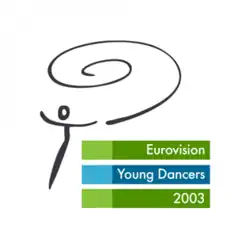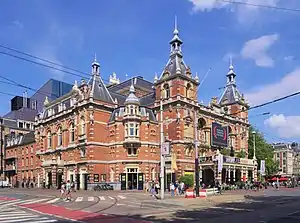Eurovision Young Dancers 2003
The Eurovision Young Dancers 2003 was the tenth edition of the Eurovision Young Dancers, held at the Stadsschouwburg Theatre in Amsterdam, Netherlands between 29 June and 4 July 2003.[1] Organised by the European Broadcasting Union (EBU) and host broadcaster Nederlandse Programma Stichting (NPS), dancers from ten countries participated in the televised final. A total of seventeen countries took part in the competition therefore a semi-final was held a few days before at the same venue. Armenia and Romania made their début while Austria, Germany and Ireland decided not to participate.[1]
| Eurovision Young Dancers 2003 | |
|---|---|
 | |
| Dates | |
| Semi-final | 2 July 2003 |
| Final | 4 July 2003 |
| Host | |
| Venue | Stadsschouwburg, Amsterdam, Netherlands |
| Presenter(s) | Aldith Hunkar |
| Directed by | Ross MacGibbon |
| Executive supervisor | Sarah Yuen |
| Executive producer | Henk van der Meulen |
| Host broadcaster | Nederlandse Programma Stichting (NPS) |
| Website | youngdancers |
| Participants | |
| Number of entries | 17 |
| Debuting countries | |
| Returning countries | None |
| Non-returning countries | |
Participation map
| |
| Vote | |
| Voting system | A professional jury chose the finalists and gave points to each performance |
| Winning dancers |
|
The semi-final took place on 2 July 2003.[2] Each country could send one or two dancers, male or female, not older than 20. All countries except the host (Netherlands) had to take part in the semi-final.[1]
The non-qualified countries were Armenia, Belgium, Cyprus, Norway, Poland, Slovenia and United Kingdom. Kristina Oom and Sebastian Michanek of Sweden won the contemporary dance prize, with Jerlin Ndudi of Ukraine winning the classical dance prize. Monika Hejduková and Viktor Konvalinka of Czech Republic won the 'Youth Jury Choice' award.[3]
Location

Stadsschouwburg Theatre in Amsterdam, Netherlands was the host venue for the 2003 edition of the Eurovision Young Dancers.[1] The building is in the neo-Renaissance style dating back to 1894, and is the former home of the National Ballet and Opera.[4]
Format
The format consists of dancers who are non-professional and between the ages of 16–21, competing in a performance of dance routines of their choice, which they have prepared in advance of the competition. All of the acts then take part in a choreographed group dance during 'Young Dancers Week'.[5]
Jury members of a professional aspect and representing the elements of ballet, contemporary, and modern dancing styles, score each of the competing individual and group dance routines. The overall winner upon completion of the final dances is chosen by the professional jury members.[5] All participants received a medal, designed by Dutch artist Dinie Besems.[2]
There was no interval act this year, with footage of previous contest winners and an offstage interview with Agnès Letestu, winner of the contemporary dance prize in 1989, broadcast instead.
Results
Preliminary round
A total of seventeen countries took part in the preliminary round of the 2003 contest, of which ten qualified to the televised grand final. The following countries failed to qualify.[1][6]
| Country | Participant | Dance | Choreographer |
|---|---|---|---|
| Kate Lyons | "The Girl" | M. Baldwin | |
| Sébastien Tassin | "Coppélia" | A. Saint-Léon | |
| Natalia Krekou | "After" | A. Hatjieftychiou | |
| Anže Škrube | "Club Hoppin" | D. Popovski | |
| Avetik Karapetyan | "Rhythm of Spirit" | H. Divanyan | |
| Caroline Roca | "Afraid of Beauty" | P. Touzeau | |
| Jakub Greda | "Solo Hip-Hop" | A. Grazul and R. Ziolkowski |
Final
There were 2 prizes given this year: one for contemporary dance (awarded to Sweden) and one for classical ballet dance (awarded to Ukraine). A special "young jury" award was given as well by a group of young viewers that were in the audience, this went to contemporary runner-up Czech Republic.[1][7]
Classical category
| Country | Participant | Dance | Choreographer | Place | Points |
|---|---|---|---|---|---|
| Jerlin Ndudi | "Le Corsaire" | M. Petipa | 1 | 938 | |
| Maria Seletskaja | "Swan Lake" | M. Petipa | 3 | 800 | |
| Tiina Myllymäki | "Paquita" | Makarova and M. Petipa | 5 | 745 | |
| Elenina Nicolaou | M. Petipa | 6 | 716 | ||
| Ovidiu Matei Iancu | "Swan Lake" | 2 | 831 | ||
| Sarah-Jane Brodbeck | "Don Quixote" | 4 | 793 |
Contemporary category
| Country | Participant | Dance | Choreographer | Place | Points |
|---|---|---|---|---|---|
| Kristina Oom and Sebastian Michanek | "Light Beings" | M. Ek | 1 | 907 | |
| Monika Hejduková and Viktor Konvalinka | "The Twilight Of Innocence" | Kodel and Vágnerová | 2 | 856 | |
| Joeri Dubbe | "Perfect Skin" | E. Wubbe | 3 | 781 | |
| Linda Siliņa | "La Primavera" | I. Lapsiņa | 4 | 777 |
Jury members
The jury members consisted of the following:[1]
 Russia – Vladimir Vasiliev
Russia – Vladimir Vasiliev Germany – Susanne Linke
Germany – Susanne Linke.svg.png.webp) Italy – Paola Cantalupo
Italy – Paola Cantalupo Netherlands – Derrick Brown
Netherlands – Derrick Brown United States – Liz Imperio
United States – Liz Imperio
Broadcasting
26 national broadcasters[8] in 24 countries transmitted the 2003 event.[9] Albania, Croatia, Germany, Iceland, Puerto Rico, and Serbia and Montenegro all broadcast the contest in addition to the competing countries.
 Albania (RTVSH)
Albania (RTVSH) Armenia (ARMTV)
Armenia (ARMTV).svg.png.webp) Belgium (RTBF)
Belgium (RTBF) Croatia (HRT)
Croatia (HRT).svg.png.webp) Cyprus (CyBC)
Cyprus (CyBC) Czech Republic (ČT)
Czech Republic (ČT) Estonia (ETV)
Estonia (ETV) Finland (Yle)
Finland (Yle) Germany (3sat)
Germany (3sat) Greece (ERT)
Greece (ERT) Iceland (RÚV)
Iceland (RÚV) Latvia (LTV)
Latvia (LTV) Netherlands (NOS, NPS)
Netherlands (NOS, NPS) Norway (NRK)
Norway (NRK) Poland (TVP2)
Poland (TVP2) Puerto Rico
Puerto Rico Romania (TVR2)
Romania (TVR2).svg.png.webp) Serbia and Montenegro (UJRT)
Serbia and Montenegro (UJRT) Slovenia (RTVSLO)
Slovenia (RTVSLO) Sweden (SVT)
Sweden (SVT).svg.png.webp) Switzerland (DRS, TSI, TSR)
Switzerland (DRS, TSI, TSR) Ukraine (NTU)
Ukraine (NTU) United Kingdom (BBC)
United Kingdom (BBC)
Notes and references
Notes
- Armenia took part for the first time in the semi-final since they did not reach the final. Their debut in a Final of the Young Dancers contest took place in 2013
References
- "Eurovision Young Dancers 2003: About the show". European Broadcasting Union. Retrieved 5 October 2014.
- "10th Eurovision Young Dancers". EBU. 13 February 2013. Archived from the original on 13 February 2013. Retrieved 3 May 2018.
- "Eurovision Young Dancers 2003: Participants". youngmusicians.tv. European Broadcasting Union. Retrieved 5 October 2014.
- Martin Dunford (2010). The Rough Guide to The Netherlands. Penguin. p. 74. ISBN 978-1-84836-882-8.
- "Eurovision Young Dancers - Format". youngdancers.tv. European Broadcasting Union. Archived from the original on 11 February 2015. Retrieved 8 March 2015.
- "Eurovision Young Dancers 2003". 10 October 2004. Archived from the original on 10 October 2004. Retrieved 5 May 2019.
- "Eurovision Young Dancers Awards Ukrainian and Swedish winners". 7 July 2003. Archived from the original on 24 December 2004. Retrieved 9 October 2019.
- "Eurovision Young Dancers 2003". 2 June 2011. Archived from the original on 2 June 2011. Retrieved 3 May 2018.
- (PDF). young-dancers.com. 31 March 2004 https://web.archive.org/web/20040331044323/http://www.young-dancers.com:80/participate/2003_Countries_Broadcastrs.pdf. Archived from the original (PDF) on 31 March 2004. Retrieved 3 May 2018.
{{cite web}}: Missing or empty|title=(help)
